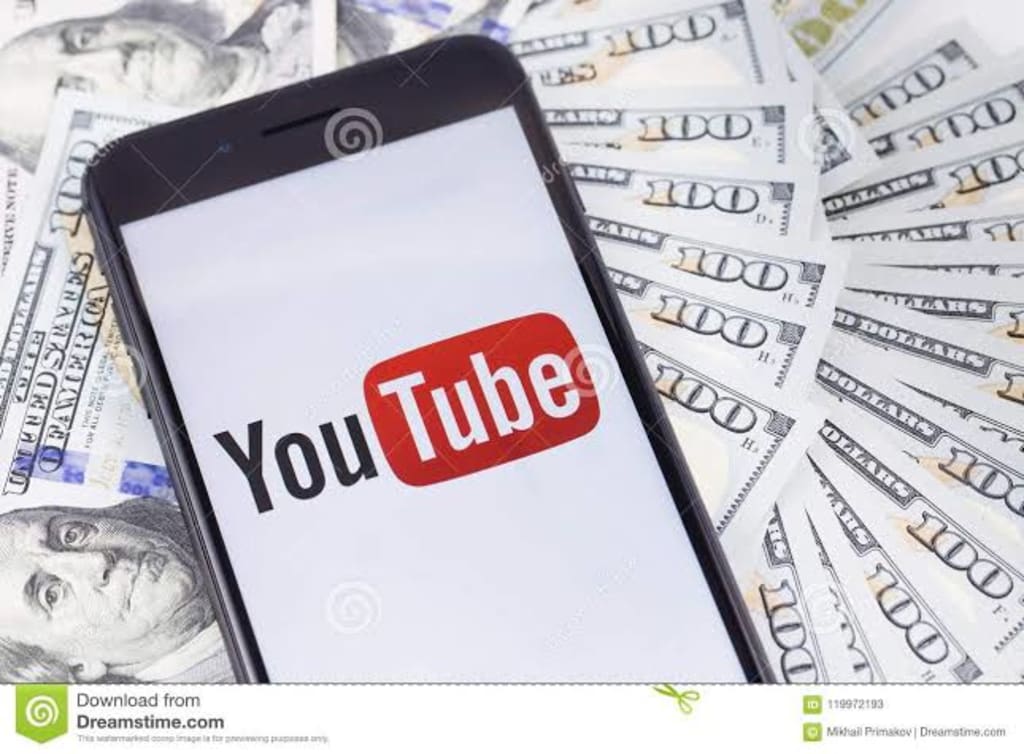Building a Successful YouTube Channel
Become a millionaire

"Building a Successful YouTube Channel: Tips, Tricks and Strategies for Growing Your Audience and Monetizing Your Content"
I. Introduction
A. Explanation of the importance of YouTube in today's digital landscape:
YouTube is one of the most popular and widely used platforms on the internet today. With over 2 billion monthly active users, it's a powerful tool for reaching a global audience and building a community around your brand or content. The platform has become a go-to destination for entertainment, education, and information, making it an essential part of the digital landscape. Many individuals, businesses, and organizations use YouTube to market their products and services, promote their brand, and connect with their audience. The platform's ability to offer a wide range of content, from videos to live streams, makes it a perfect channel for audience engagement and building a loyal fan base. Additionally, YouTube's algorithm rewards creators for regularly posting content, which makes it a great way to grow a channel, gain visibility and reach a wide audience.
B. Overview of the main topics that will be covered in the blog
The blog will cover a wide range of topics related to building a successful YouTube channel. It will delve into the importance of creating engaging content that resonates with your target audience, and provide tips and strategies for developing a content strategy that aligns with your goals. The blog will also cover best practices for creating and editing videos, as well as techniques for optimizing your videos for search and discovery.
In addition, the blog will explore various ways of building an audience, such as how to use social media to promote your channel, tips for networking and collaborating with other YouTubers, as well as strategies for leveraging SEO to increase visibility. The blog will also cover how to use analytics to track and improve your channel's performance.
The blog will also delve into monetizing your channel, by covering the different ways to make money on YouTube and providing best practices for creating sponsored content and working with brands. The blog will also cover how to use YouTube's tools to track and manage revenue.
Lastly, the blog will provide a summary of key takeaways, additional resources for further learning and growth and encouragement to implement the strategies and tips discussed in the blog.
II. Creating Engaging Content
A. Importance of understanding your target audience
Understanding your target audience is crucial in developing effective communication and marketing strategies. By understanding the demographics, needs, and interests of your target audience, you can tailor your messaging and approach to effectively reach and engage them. This can lead to increased conversions, sales, and customer loyalty. Additionally, understanding your target audience can help you identify new opportunities and make informed business decisions
B. Tips for developing a content strategy
Define your target audience: Understand the demographics, needs, and interests of your target audience.
Set clear goals: Establish specific, measurable goals for your content, such as increasing website traffic or building brand awareness.
Conduct a content audit: Review your existing content and identify any gaps or opportunities.
Identify your unique value proposition: Understand what sets your brand apart and how your content can communicate this.
Develop a content calendar: Plan out your content in advance and schedule it for optimal timing.
Create a variety of content: Use a mix of different types of content, such as blog posts, videos, infographics, and social media updates, to keep your audience engaged.
Optimize for SEO: Use keywords and meta tags to make sure your content is easily discoverable by search engines.
Promote your content: Share your content across multiple channels, including social media, email, and influencer partnerships.
Measure and analyze your results: Track your performance using analytics tools and make adjustments to your strategy as needed.
Continuously improve: Regularly review and update your content strategy to keep it aligned with your goals and audience needs.
C. Best practices for creating and editing videos
Plan ahead: Before filming, create a detailed script and storyboard, and consider the logistics of filming, such as lighting and sound.
Use high-quality equipment: Invest in a good camera, microphone, and lighting equipment to ensure that your video looks and sounds professional.
Be mindful of composition: Use the rule of thirds and other composition techniques to create visually pleasing shots.
Use b-roll footage: In addition to the main footage, include b-roll footage to add context and interest to your video.
Keep it short: Attention span of viewers are generally short, aim to keep your videos under 2 minutes if possible.
Add captions: Add captions to your videos to make them accessible to a wider audience, including those who are deaf or hard of hearing.
Optimize for different platforms: Different platforms have different aspect ratios and resolution requirements, so make sure your videos are optimized for each platform you plan to share them on.
Edit for pacing and flow: Use editing techniques such as cutting on action and cross-cutting to create a sense of movement and keep the video moving.
Use music and sound effects: Add music and sound effects to enhance the mood and emotion of your video.
Review and revise: Watch your video multiple times and make revisions as needed to improve the overall quality and effectiveness of your video.
D. How to optimize your videos for search and discovery
Use keywords in the title and description: Use relevant keywords in the title and description of your video to make it more discoverable in search results.
Add closed captions and subtitles: Not only it makes your video more accessible, but it also allows search engines to understand the content of your video, and make it more discoverable.
Use tags: Use tags to help search engines understand the content of your video and the topics it covers.
Create a video sitemap: Submit a video sitemap to search engines to help them crawl and index your video.
Use a video hosting platform: Host your video on a platform such as YouTube or Vimeo, as these platforms are more likely to be indexed by search engines.
III. Building an Audience
A. How to use social media to promote your channel
Share your videos on social media: Share your videos on platforms such as Facebook, Twitter, and Instagram to increase their visibility and reach a wider audience.
Use hashtags: Use relevant hashtags to make your videos more discoverable on social media.
Collaborate with other creators: Collaborate with other creators in your niche to reach new audiences and gain exposure for your channel.
Use social media ads: Use social media advertising to promote your videos to a targeted audience.
Engage with your followers: Respond to comments and messages, and create a sense of community around your channel.
Create a consistent brand image: Use a consistent profile picture, cover photo and
B. Tips for networking and collaborating with other YouTubers
Reach out to other creators in your niche: Find other YouTubers who create content similar to yours and reach out to them to collaborate.
Attend events and meetups: Attend events and meetups related to YouTube and online video to meet other creators in person.
Join online communities: Join online communities such as Facebook groups or forums to connect with other YouTubers and share advice and tips.
Collaborate on content: Collaborate with other YouTubers to create content together, such as video series or cross-promotion.
Promote each other: Share each other's videos and content on your own channels to gain exposure for both of you.
C. Strategies for leveraging SEO to increase visibility
Use keywords in your video titles, descriptions, and tags: Use relevant keywords in your video titles, descriptions, and tags to help search engines understand the content of your video and make it more discoverable.
Optimize your video's metadata: Provide a clear and concise title, description, and tags that accurately reflect the content of your video.
Create a video sitemap: Create and submit a video sitemap to search engines to help them crawl and index your videos.
Create a YouTube channel and upload your videos there: YouTube is the second largest search engine and having a channel there can help with visibility.
Optimize your video thumbnail: Use a visually appealing and relevant thumbnail image to encourage users to click on and watch your video.
D. How to use analytics to track and improve performance
Track views, engagement, and retention: Use analytics tools to track how many views your videos are getting, how long viewers are watching them for, and how many are interacting with them.
Monitor audience demographics: Use analytics tools to understand the demographics of your audience, such as their age, gender, and location.
Identify your top-performing videos: Use analytics tools to identify which of your videos are performing the best, in terms of views, engagement, and retention.
Understand your audience's behavior: Use analytics tools to understand how your audience is interacting with your videos and what actions they are taking, such as subscribing or clicking through to your website.
Use A/B testing: Try different video titles, descriptions, and thumbnails to see which perform better, and use the data to optimize your future videos.
IV. Monetizing Your Channel
A. Overview of the different ways to make money on YouTube
There are several ways to monetize a YouTube channel:
Ad revenue: YouTube pays creators a percentage of the ad revenue generated from ads shown on their videos.
Sponsorships: YouTubers can get sponsored by brands to create content for or feature their products in their videos.
Affiliate marketing: YouTubers can earn commission by including affiliate links to products in their videos and encouraging viewers to purchase them.
Merchandise: YouTubers can sell merchandise, such as t-shirts, mugs or any other products related to their channel or brand.
Crowdfunding: YouTubers can use platforms like Patreon to receive recurring funding from fans to support their channel.
B. How to set up and manage a YouTube Partner Program account
Sign in to your YouTube account: Make sure you are signed in to the YouTube account that you want to monetize.
Enable monetization: Go to your YouTube settings and click on the Monetization tab. From there, you can enable monetization for your account.
Connect to AdSense: YouTube will prompt you to connect your account to an AdSense account in order to receive payments for ad revenue. If you don't have an AdSense account, you can create one for free.
Create a content owner: If you are not the only one creating content for the channel, you'll have to create a content owner and grant them access to monetize the content.
Agree to the terms: Review and agree to the YouTube Partner Program terms and policies.
C. Best practices for creating sponsored content and working with brands
Be selective with the brands you work with: Only work with brands that align with your values and those of your audience.
Be transparent: Make it clear to your audience when a video is sponsored or contains affiliate links.
Provide value: Create sponsored content that provides value to your audience, not just a sales pitch for the brand.
Be creative: Come up with creative and interesting ways to incorporate the brand into your content.
Maintain control over your content: Negotiate terms that allow you to maintain creative control over your sponsored content.
D. How to use YouTube's tools to track and manage revenue
To track and manage revenue on YouTube, you can use the YouTube Studio and the YouTube Analytics tool.
In the YouTube Studio, you can access the monetization section to see your estimated earnings, view your revenue sources and manage your monetization settings.
In YouTube Analytics, you can access detailed information about your revenue, such as views, earnings, and ad performance. You can also use it to track the performance of individual videos and see which ones are generating the most revenue.
V. Conclusion
A. Summary of key takeaways from the blog
You can use YouTube Studio and YouTube Analytics to track and manage revenue on the platform.
The monetization section in YouTube Studio allows you to see estimated earnings and manage monetization settings.
YouTube Analytics provides detailed information about revenue, views, earnings, and ad performance.
You can use YouTube's Partner Program to earn money from ads and sponsorships.
B. Additional resources for further learning and growth
The YouTube Creator Academy (https://creatoracademy.youtube.com/) offers a range of free resources and tutorials for creators looking to grow their channel and monetize their content.
The YouTube Creator Blog (https://youtube.com/creators) offers tips and best practices for creators to improve their content, grow their audience and monetize their channel.
The YouTube Help Center (https://support.google.com/youtube/) provides a wide range of resources and troubleshooting guides for creators and publishers.
The YouTube Creator Community (https://www.youtube.com/yt/creators/community.html) is a forum where creators can connect with other creators, ask questions, and share knowledge and tips.
Creator Insider (https://www.youtube.com/channel/UCGg-UqjRgzhYDPJMr-9HXCg) is a YouTube channel for creators, by creators, where they share tips, tricks and insights about YouTube.
C. Encouragement to implement the strategies and tips discussed in the blog
It is important to remember that success on YouTube takes time and effort. Implementing the strategies and tips discussed in the blog will take dedication and consistency. It's crucial to stay patient and persistent as you work to grow your channel and monetize your content. Remember that every successful creator started small and it takes time to build an audience and establish a revenue stream. Keep creating high-quality content, be consistent with your upload schedule, and engage with your audience. Utilize the tools and resources available to track and optimize your performance, and don't be afraid to experiment with different monetization strategies. With hard work and perseverance, you can achieve your goals on YouTube.
About the Creator
Enjoyed the story? Support the Creator.
Subscribe for free to receive all their stories in your feed. You could also pledge your support or give them a one-off tip, letting them know you appreciate their work.






Comments
There are no comments for this story
Be the first to respond and start the conversation.